2005 BMW Z4 ROADSTER 2.5I child restraint
[x] Cancel search: child restraintPage 29 of 120
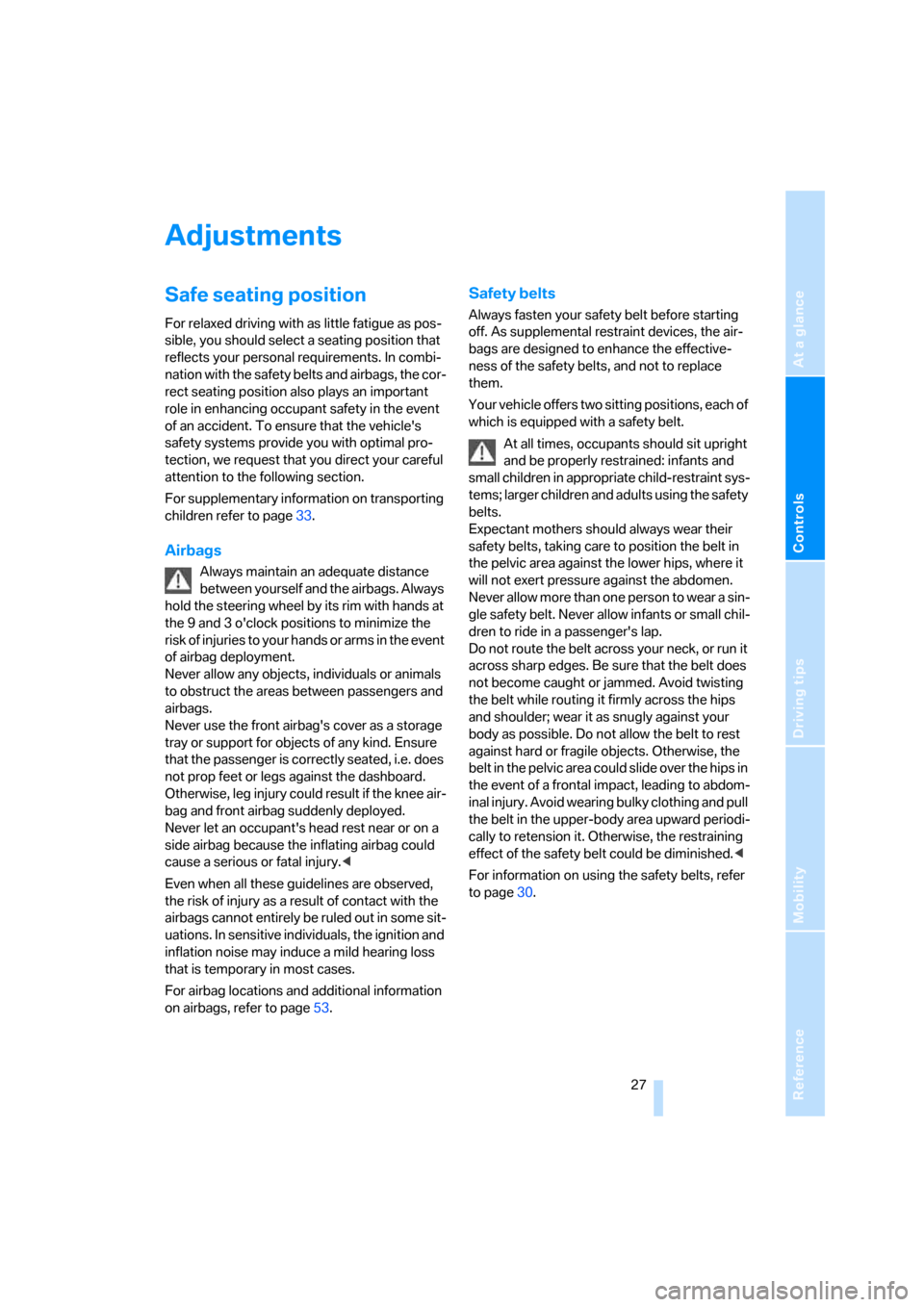
Reference
At a glance
Controls
Driving tips
Mobility
27
Adjustments
Safe seating position
For relaxed driving with as little fatigue as pos-
sible, you should select a seating position that
reflects your personal requirements. In combi-
nation with the safety belts and airbags, the cor-
rect seating position also plays an important
role in enhancing occupant safety in the event
of an accident. To ensure that the vehicle's
safety systems provide you with optimal pro-
tection, we request that you direct your careful
attention to the following section.
For supplementary information on transporting
children refer to page33.
Airbags
Always maintain an adequate distance
between yourself and the airbags. Always
hold the steering wheel by its rim with hands at
the 9 and 3 o'clock positions to minimize the
r i s k o f i n j u r i e s t o y o u r h a n d s o r a r m s i n t h e e v e n t
of airbag deployment.
Never allow any objects, individuals or animals
to obstruct the areas between passengers and
airbags.
Never use the front airbag's cover as a storage
tray or support for objects of any kind. Ensure
that the passenger is correctly seated, i.e. does
not prop feet or legs against the dashboard.
Otherwise, leg injury could result if the knee air-
bag and front airbag suddenly deployed.
Never let an occupant's head rest near or on a
side airbag because the inflating airbag could
cause a serious or fatal injury.<
Even when all these guidelines are observed,
the risk of injury as a result of contact with the
airbags cannot entirely be ruled out in some sit-
uations. In sensitive individuals, the ignition and
inflation noise may induce a mild hearing loss
that is temporary in most cases.
For airbag locations and additional information
on airbags, refer to page53.
Safety belts
Always fasten your safety belt before starting
off. As supplemental restraint devices, the air-
bags are designed to enhance the effective-
ness of the safety belts, and not to replace
them.
Your vehicle offers two sitting positions, each of
which is equipped with a safety belt.
At all times, occupants should sit upright
and be properly restrained: infants and
small children in appropriate child-restraint sys-
tems; larger children and adults using the safety
belts.
Expectant mothers should always wear their
safety belts, taking care to position the belt in
the pelvic area against the lower hips, where it
will not exert pressure against the abdomen.
N e v e r a l l o w m o r e t h a n o n e p e r s o n t o w e a r a si n -
gle safety belt. Never allow infants or small chil-
dren to ride in a passenger's lap.
Do not route the belt across your neck, or run it
across sharp edges. Be sure that the belt does
not become caught or jammed. Avoid twisting
the belt while routing it firmly across the hips
and shoulder; wear it as snugly against your
body as possible. Do not allow the belt to rest
against hard or fragile objects. Otherwise, the
belt in the pelvic area could slide over the hips in
the event of a frontal impact, leading to abdom-
inal injury. Avoid wearing bulky clothing and pull
the belt in the upper-body area upward periodi-
cally to retension it. Otherwise, the restraining
effect of the safety belt could be diminished.<
For information on using the safety belts, refer
to page30.
Page 35 of 120
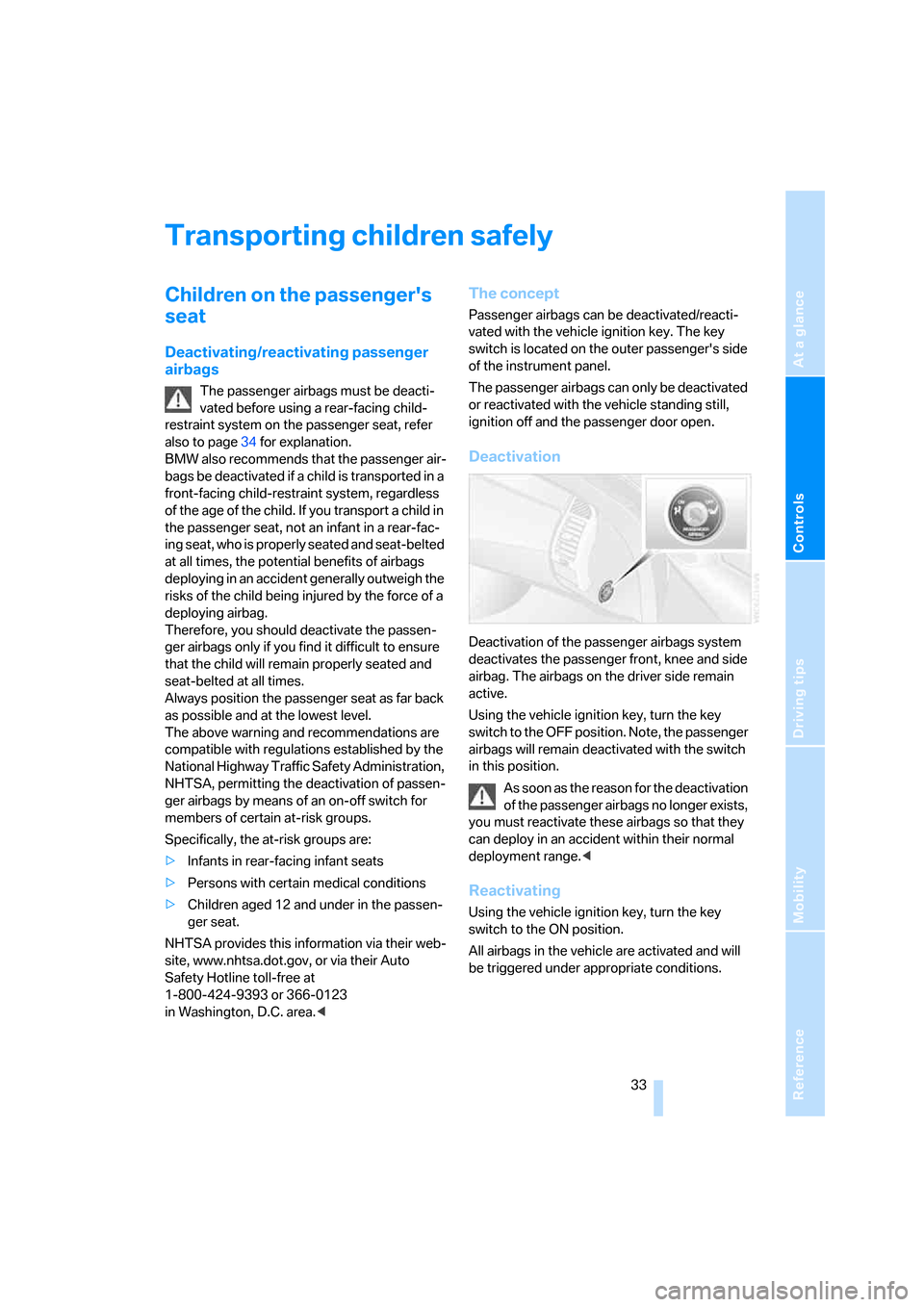
Reference
At a glance
Controls
Driving tips
Mobility
33
Transporting children safely
Children on the passenger's
seat
Deactivating/reactivating passenger
airbags
The passenger airbags must be deacti-
vated before using a rear-facing child-
restraint system on the passenger seat, refer
also to page34 for explanation.
BMW also recommends that the passenger air-
bags be deactivated if a child is transported in a
front-facing child-restraint system, regardless
of the age of the child. If you transport a child in
the passenger seat, not an infant in a rear-fac-
ing seat, who is properly seated and seat-belted
at all times, the potential benefits of airbags
deploying in an accident generally outweigh the
risks of the child being injured by the force of a
deploying airbag.
Therefore, you should deactivate the passen-
ger airbags only if you find it difficult to ensure
that the child will remain properly seated and
seat-belted at all times.
Always position the passenger seat as far back
as possible and at the lowest level.
The above warning and recommendations are
compatible with regulations established by the
National Highway Traffic Safety Administration,
NHTSA, permitting the deactivation of passen-
ger airbags by means of an on-off switch for
members of certain at-risk groups.
Specifically, the at-risk groups are:
>Infants in rear-facing infant seats
>Persons with certain medical conditions
>Children aged 12 and under in the passen-
ger seat.
NHTSA provides this information via their web-
site, www.nhtsa.dot.gov, or via their Auto
Safety Hotline toll-free at
1-800-424-9393 or 366-0123
in Washington, D.C. area.<
The concept
Passenger airbags can be deactivated/reacti-
vated with the vehicle ignition key. The key
switch is located on the outer passenger's side
of the instrument panel.
The passenger airbags can only be deactivated
or reactivated with the vehicle standing still,
ignition off and the passenger door open.
Deactivation
Deactivation of the passenger airbags system
deactivates the passenger front, knee and side
airbag. The airbags on the driver side remain
active.
Using the vehicle ignition key, turn the key
switch to the OFF position. Note, the passenger
airbags will remain deactivated with the switch
in this position.
As soon as the reason for the deactivation
of the passenger airbags no longer exists,
you must reactivate these airbags so that they
can deploy in an accident within their normal
deployment range.<
Reactivating
Using the vehicle ignition key, turn the key
switch to the ON position.
All airbags in the vehicle are activated and will
be triggered under appropriate conditions.
Page 36 of 120

Transporting children safely
34
Passenger airbags lamp
The center console contains one of the indica-
tor lamps shown in the illustration.
The system checks that the airbag system is
functioning properly when the ignition key is
turned, and the indicator lamp in the central
console lights up for several seconds.
>The indicator lamp lights up continuously
when the passenger airbags are deacti-
vated
>If the passenger airbags are activated, it
goes out after several seconds
The passenger airbags are deactivated
when the key switch is in the ON position
and the passenger seat is unoccupied. The
indicator lamp is not lit.<
At all times, occupants should sit com-
fortably upright and be properly
restrained: infants and small children in appro-
priate child-restraint systems; larger children
and adults using the safety belts. Please note
that the word Airbag imprinted on the door trim
panel indicates the airbag's location.<
Seating position for children
This is the correct way a larger child no longer
using a child-restraint system should sit wear-ing the safety belt, when the airbag system is
activated.
Installing child-restraint
systems
Before installing any child-restraint system or
child seat, read the following:
Never install a rear-facing child-restraint
system in the passenger seat of this vehi-
cle, unless the passenger airbags have been
turned off and the indicator lamp in the center
console indicates that the passenger airbags
are deactivated. For a child, not an infant, cer-
tain precautions should be taken. Position the
passenger seat as far back as possible and at
the lowest level. This important precaution is
intended to maximize the distance between the
airbags and the child. Younger children should
be secured in an appropriate forward-facing
child-restraint system that has first been prop-
erly secured. Older children should be tightly
secured with a safety belt, sitting with their back
against the vehicle seat back. Always ensure
that all occupants, of all ages, remain properly
and securely restrained at all times.<
Always follow the manufacturer's instruc-
tions concerning installation and use;
otherwise the system's protective function
could be impaired. After an accident, have all
parts of the affected safety belt system
inspected and/or replaced by your BMW cen-
ter.<
Commercially-available child-restraint systems
are designed to be secured with a lap belt or
with the lap belt portion of a combination lap/
shoulder belt. Improperly or inadequately
installed restraint systems can increase the risk
of injury to children. Always read and follow the
instructions that come with the system.
Page 37 of 120
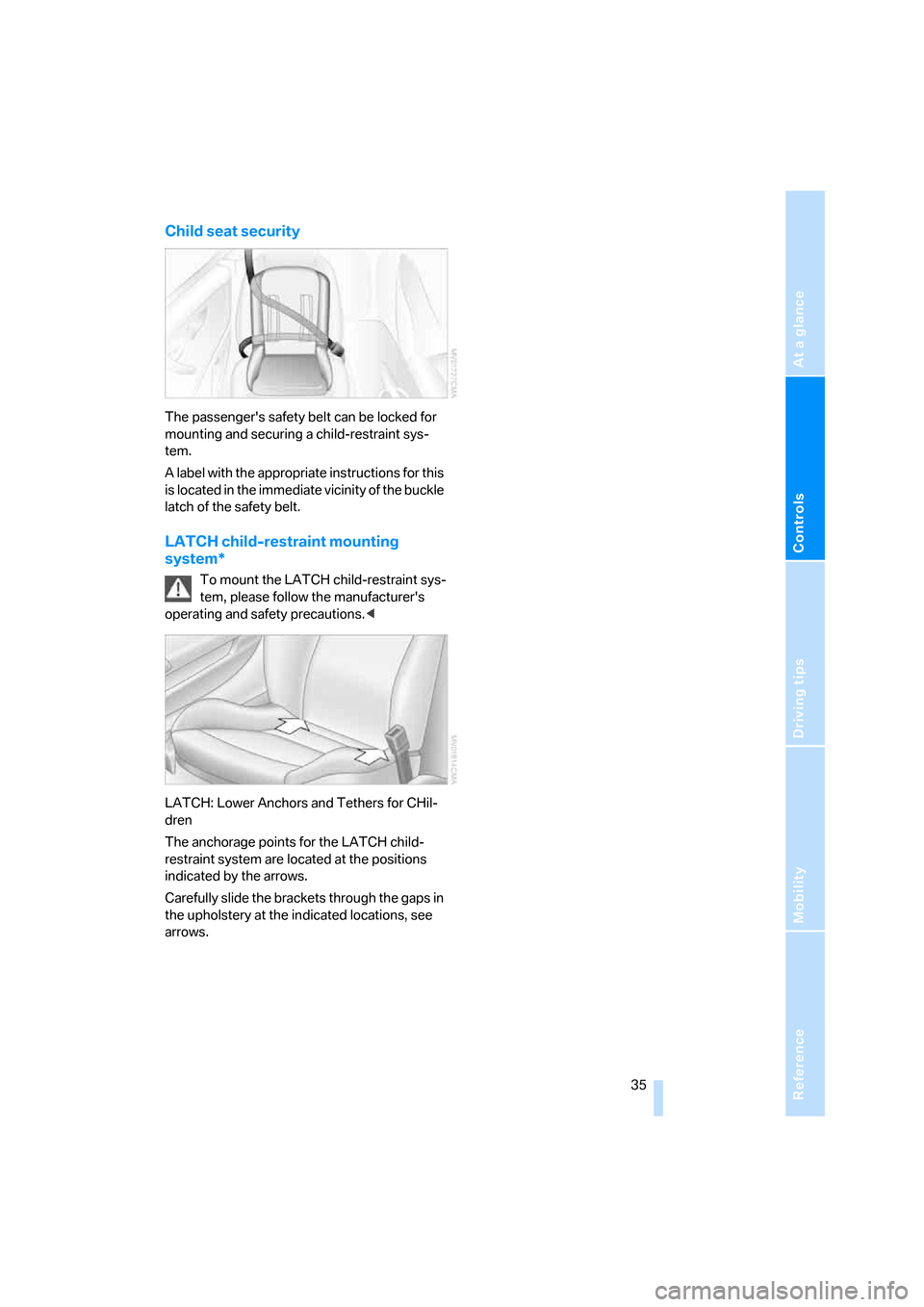
Reference
At a glance
Controls
Driving tips
Mobility
35
Child seat security
The passenger's safety belt can be locked for
mounting and securing a child-restraint sys-
tem.
A label with the appropriate instructions for this
is located in the immediate vicinity of the buckle
latch of the safety belt.
LATCH child-restraint mounting
system*
To mount the LATCH child-restraint sys-
tem, please follow the manufacturer's
operating and safety precautions.<
LATCH: Lower Anchors and Tethers for CHil-
dren
The anchorage points for the LATCH child-
restraint system are located at the positions
indicated by the arrows.
Carefully slide the brackets through the gaps in
the upholstery at the indicated locations, see
arrows.
Page 56 of 120
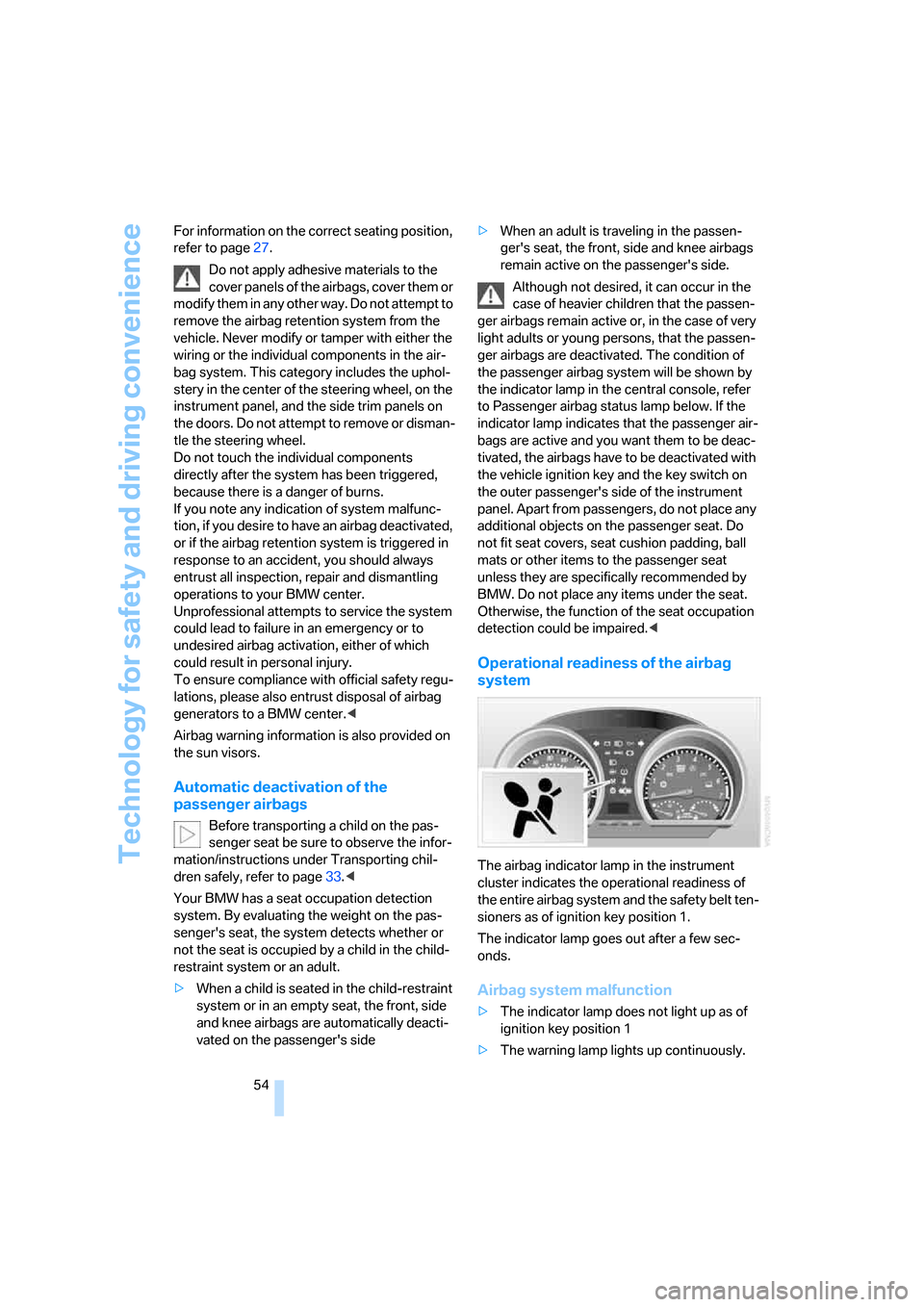
Technology for safety and driving convenience
54 For information on the correct seating position,
refer to page27.
Do not apply adhesive materials to the
cover panels of the airbags, cover them or
modify them in any other way. Do not attempt to
remove the airbag retention system from the
vehicle. Never modify or tamper with either the
wiring or the individual components in the air-
bag system. This category includes the uphol-
stery in the center of the steering wheel, on the
instrument panel, and the side trim panels on
the doors. Do not attempt to remove or disman-
tle the steering wheel.
Do not touch the individual components
directly after the system has been triggered,
because there is a danger of burns.
If you note any indication of system malfunc-
tion, if you desire to have an airbag deactivated,
or if the airbag retention system is triggered in
response to an accident, you should always
entrust all inspection, repair and dismantling
operations to your BMW center.
Unprofessional attempts to service the system
could lead to failure in an emergency or to
undesired airbag activation, either of which
could result in personal injury.
To ensure compliance with official safety regu-
lations, please also entrust disposal of airbag
generators to a BMW center.<
Airbag warning information is also provided on
the sun visors.
Automatic deactivation of the
passenger airbags
Before transporting a child on the pas-
senger seat be sure to observe the infor-
mation/instructions under Transporting chil-
dren safely, refer to page33.<
Your BMW has a seat occupation detection
system. By evaluating the weight on the pas-
senger's seat, the system detects whether or
not the seat is occupied by a child in the child-
restraint system or an adult.
>When a child is seated in the child-restraint
system or in an empty seat, the front, side
and knee airbags are automatically deacti-
vated on the passenger's side>When an adult is traveling in the passen-
ger's seat, the front, side and knee airbags
remain active on the passenger's side.
Although not desired, it can occur in the
case of heavier children that the passen-
ger airbags remain active or, in the case of very
light adults or young persons, that the passen-
ger airbags are deactivated. The condition of
the passenger airbag system will be shown by
the indicator lamp in the central console, refer
to Passenger airbag status lamp below. If the
indicator lamp indicates that the passenger air-
bags are active and you want them to be deac-
tivated, the airbags have to be deactivated with
the vehicle ignition key and the key switch on
the outer passenger's side of the instrument
panel. Apart from passengers, do not place any
additional objects on the passenger seat. Do
not fit seat covers, seat cushion padding, ball
mats or other items to the passenger seat
unless they are specifically recommended by
BMW. Do not place any items under the seat.
Otherwise, the function of the seat occupation
detection could be impaired.<
Operational readiness of the airbag
system
The airbag indicator lamp in the instrument
cluster indicates the operational readiness of
the entire airbag system and the safety belt ten-
sioners as of ignition key position 1.
The indicator lamp goes out after a few sec-
onds.
Airbag system malfunction
>The indicator lamp does not light up as of
ignition key position 1
>The warning lamp lights up continuously.
Page 57 of 120
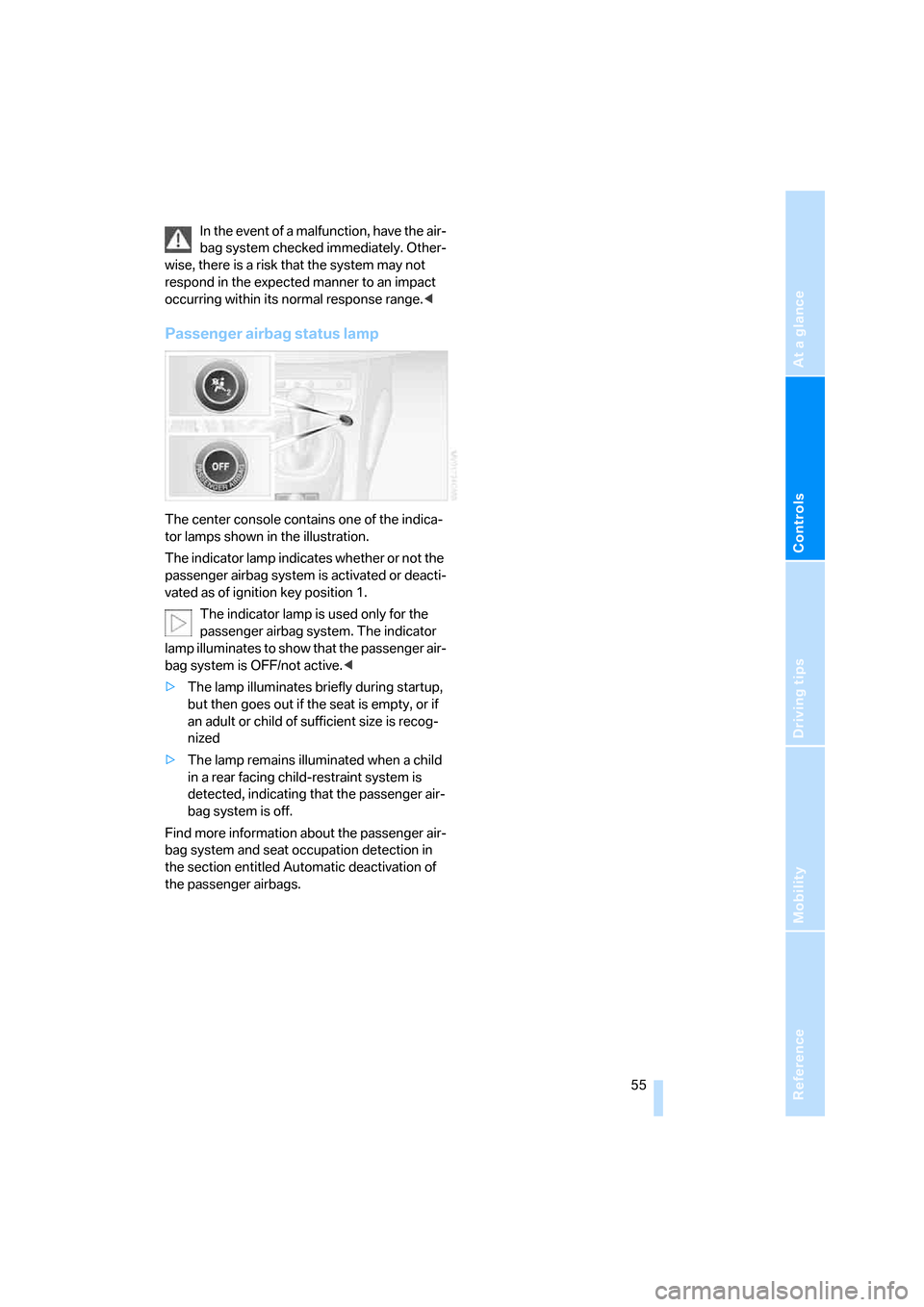
Reference
At a glance
Controls
Driving tips
Mobility
55
In the event of a malfunction, have the air-
bag system checked immediately. Other-
wise, there is a risk that the system may not
respond in the expected manner to an impact
occurring within its normal response range.<
Passenger airbag status lamp
The center console contains one of the indica-
tor lamps shown in the illustration.
The indicator lamp indicates whether or not the
passenger airbag system is activated or deacti-
vated as of ignition key position 1.
The indicator lamp is used only for the
passenger airbag system. The indicator
lamp illuminates to show that the passenger air-
bag system is OFF/not active.<
>The lamp illuminates briefly during startup,
but then goes out if the seat is empty, or if
an adult or child of sufficient size is recog-
nized
>The lamp remains illuminated when a child
in a rear facing child-restraint system is
detected, indicating that the passenger air-
bag system is off.
Find more information about the passenger air-
bag system and seat occupation detection in
the section entitled Automatic deactivation of
the passenger airbags.
Page 109 of 120

Reference
At a glance
Controls
Driving tips
Mobility
107
Bandages, refer to First-aid
kit97
Bar, towing99
Battery94
– charging95
– disposal95
– indicator lamp12,94
– jump-starting97
– power supply interruption95
– remote control16
Belts, refer to Safety belts30
Belt tensioner, refer to Safety
belts30
Beverage holders64
Blower
– air conditioning59
– automatic climate control62
Blower, refer to Air
supply59,62
BMW5
BMW Maintenance
System89
Bottle holders, refer to
Beverage holders64
Brake fluid88
– filling88
– indicator/warning
lamp13,88
– level88
Brake force display52
Brake hydraulic system88
– indicator/warning
lamp13,88
Brake lamps
– brake force display52
– bulb replacement93
– indicator lamp, defective
lamp13
Brake pads88
– break-in procedures68
– warning lamp88
Brake pad wear indicator
– brake pads88
– warning lamp13
Brake rotors
– brake system69
– break-in procedures68Brakes
– ABS50
– brake fluid88
– brake pads88
– break-in procedures68
– indicator/warning
lamps13,51
– parking brake37
Brake system
– brake fluid88
– brake pads88
– break-in procedures68
– disc brakes69
– indicator lamp13
Breakdown
– Flat Tire Monitor52
Breakdown service, refer to
Mobile Service96
Breaking in the differential,
refer to Engine and
differential68
Break-in procedures68
Bridging, refer to Jump-
starting97
Bulb replacement, refer to
Lamps and bulbs91
Buttons in the multifunction
steering wheel10
C
California laws
– Event Data Recorders90
– Proposition 65 warning6
Can holders, refer to Beverage
holders64
Capacities105
Capacity
– luggage compartment, refer
to Weights103
Car battery94
Car care, refer to the Caring
for your vehicle brochure
Car-care products, refer to the
Caring for your vehicle
brochure
Care, refer to the Caring for
your vehicle brochure
Car keys, refer to Keys16Carpet care, refer to the
Caring for your vehicle
brochure
Car radio, refer to the separate
Owner's Manual
Car telephone, refer to the
separate Owner's Manual
Car wash, refer to the Caring
for your vehicle brochure
Catalytic converter, refer to
Hot exhaust system69
CD changer, refer to Owner's
Manual for Radio/Onboard
Computer
CD operation, refer to Owner's
Manual for Radio/Onboard
Computer
Center high-mount brake
lamp, bulb replacement93
Central locking system16
– interior18
Changes, technical, refer to
For your own safety6
Changing a wheel94
– Run Flat tires94
Charge indicator lamp12,94
Check gas cap, indicator
lamp13
Child-restraint mounting
system, LATCH35
Child-restraint systems33
Child seat, refer to
Installing child-restraint
systems34
Chrome parts, refer to the
Caring for your vehicle
brochure
Cigarette lighter65
Cigarette lighter socket65
Cleaning the rear window,
refer to the Caring for your
vehicle brochure
Cleaning the vehicle, refer to
the Caring for your vehicle
brochure
Page 113 of 120

Reference
At a glance
Controls
Driving tips
Mobility
111
Indicator/warning lamp
– airbags54
– alarm system26
– automatic transmission with
Steptronic39
– brakes13
– coolant temperature47
– DSC51
– engine temperature46
– Flat Tire Monitor53
– fog lamps57
– passenger airbags34
– please fasten safety belts30
– reserve46
– sequential manual gearbox
SMG41
Indicator and warning lamps,
overview12
Individual air
distribution59,62
Individual settings, refer to
Vehicle Memory,
Key Memory31
Inflation pressure, tires78
Inflation pressure monitoring,
refer to
– Flat Tire Monitor52
Inspection47
Instrument cluster12
Instrument lighting57
Instrument panel, refer to
Cockpit10
Interior lamps57
– remote control17
Interior motion sensor26
– deactivating26
Interior rearview mirror31
– automatic dimming
feature70
Interior temperature
adjusting59,62
Interlock, refer to
Steering lock36
Intermittent
– operation, wipers43
Interval
– display, service47J
Jack94
Jacking points94
Jets, refer to
Ventilation59,63
Jump-starting97
K
Key Memory31
Keys16
Key switch for passenger
airbags33
Kickdown39
Knock control76
L
Lamps and bulbs91
LATCH, child-restraint
mounting system35
Leather care, refer to the
Caring for your vehicle
brochure
LEDs Light-emitting
diodes94
Length, refer to
Dimensions104
License plate lamps, bulb
replacement94
Light-alloy wheels, care, refer
to the Caring for your vehicle
brochure
Light-emitting diodes
LEDs94
Lighter65
Lighting
of the instruments57
Lights, refer to Parking lamps/
Low beams56
LIGHTS ON warning56
Light switch56
Load, vehicle70
Loads, refer to Cargo
loading70
Loads, securing71
Lock buttons on doors,
refer to Locking18Locking the doors
– from inside18
– from outside17
Locking the vehicle
– from inside18
– from outside16
Low beams56
– automatic56
– bulb replacement92
– indicator lamp, defective
lamp13
Lug bolts, wrench91
Luggage compartment19
– capacity103
– floor panel91
– increasing capacity19
– opening/closing,
refer to Luggage
compartment lid18
– opening from inside the
vehicle19
– opening from the outside18
– opening with remote
control17
Luggage compartment lid18
– emergency operation19
– opening from inside the
vehicle19
– opening from the outside18
– remote control17
M
M+S tires, refer to Winter
tires82
Maintenance, refer to Service
interval display47,89
Maintenance System89
Making telephone calls, refer
to Owner's Manual for
Telephone
Malfunction
– convertible top23
– door lock18
– fuel filler door76
– storage compartments64
Malfunction of electrical
accessory95
Manual convertible top20